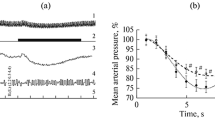Summary
The palmomental reflex (PR) was found to be of semiologic value in individual cases of 110 randomly selected patients with various diseases of the CNS even if a physiological incidence of 15% is taken into account which was observed in a control group of 50 subjects without affections of the CNS.
39 out of 63 patients with clinically manifest hemilateral symptoms of cortical origin showed a contralateral exaggeration of this exteroceptive reflex. The reflex activity was more marked homolaterally in 6 patients and about equal on both sides in 15 other patients. In 42 patients the reflex could not be elicited. 8 patients who had suffered slight head and skull injuries developed a temporary positive reflex only for 1 to 2 days which was more marked on one side.
Processes of the deep brain stem were usually associated with a marked increase of the PR on both sides. A reflex homolateral to the process may indicate the presence of a pathological process in the brain stem (2 own cases). At times, however, the reflex may predominate contralaterally (1 own case). Diagnostic errors are easily avoided when additional neurological signs attributable to the underlying lesion are found.
The PR is most marked during the initial phase of a disease, its intensity decreases during the course of the disease and may disappear entirely. In states of chronic non-progressive defects, the PR, if present at all, usually is weak apparently because adaptation to the incurred functional loss has taken place. In a progressive cerebral coma the PR and Babinski's phenomenon disappear in this order. As the level of consciousness is being restored to normal, the PR, at first absent during the deep coma, becomes detectable in the semi-conscious state to subside with complete recovery.
We regard the development of the PR under pathological conditions as a regression to phylogeneticly older patterns of innervation of the paleo-encephalon consequent to the loss of inhibitory impulses arising from pyramidal and extrapyramidal centers of the neo-encephalon.
Zusammenfassung
Die Befundanalyse von 110 unausgewählten Patienten mit Affektionen des ZNS verschiedenster Genese ergab, daß der Palmomentalreflex (PR) im Einzelfall von semiologischer Bedeutung sein kann, obgleich der Reflex in einer Kontrollgruppe von 50 Personen ohne zentralnervöse Affektion in 15% positiv war, sein physiologisches Vorkommen demnach in Rechnung gestellt werden muß.
Von 63 Patienten mit klinisch faßbaren Halbseitenerscheinungen corticaler Genese wiesen 39 eine herdgegenseitige Enthemmung dieses Fremdreflexes auf. 6 Kranke zeigten eine homolateral verstärkte Reflextätigkeit, bei 15 Patienten war der PR annähernd seitengleich enthemmt. Bei 42 Personen war der PR nicht auslösbar. 8 Patienten mit einem leichten Schädelhirntrauma zeigten nur vorübergehend über 1–2 Tage einen seitendifferenten PR ohne sonstige klinische Normabweichungen. Prozesse im Bereich des tieferen Hirnstamms wiesen meist eine starke Enthemmung des PR ohne wesentliche Seitendifferenz auf. Eine herdhomolaterale Auslösbarkeit des PR kann auf eine Prozeßlokalisation im Hirnstamm hindeuten (zwei Eigenbeobachtungen). Es kommt allerdings auch ein kontralaterales Überwiegen des Reflexes bei Herden im Hirnstamm vor (eine Einzelbeobachtung). Sofern herdspezifische Ausfälle vorliegen, bewahren diese in jedem Falle vor diagnostischen Fehlschlüssen.
Der PR ist in der initialen Krankheitsphase am deutlichsten, schwächt sich im weiteren Krankheitsverlauf ab und kann völlig verschwinden. Bei chronischen Defektzuständen pflegt der etwas vorhandene PR nur von geringer Intensität zu sein, was auf Adaptation an den Funktionsausfall zu beruhen scheint.
Im progredienten cerebralen Koma erlischt der PR vor dem Babinskischen Phänomen. Bei Aufhellung der Bewußtseinslage wird eine Stufenfolge von fehlendem PR im tiefen Koma über seine Auslösbarkeit in mittleren Graden der Bewußtseinsstörung bis zur Nichtauslösbarkeit bei eingetretener Heilung durchlaufen.
Das Wiederauftreten des PR unter pathologischen Bedingungen deuten wir als einen Rückgriff auf phylogenetisch ältere Innervations-programme des Palaeocephalon nach Wegfall pyramidaler und extrapyramidaler hemmender Informationen von seiten des Neocephalon.
Similar content being viewed by others
Literatur
Birkmayer, W., u. G. Pilleri: Die retikuläre Formation des Hirnstammes und ihre Bedeutung für das vegetativ-affektive Verhalten. Wiss. Dienst Roche, Basel 1965.
Crosby, E. C., Tr. Humphrey, and E. W. Lauer: Correlative anatomy of the nervous systems. (With contributions by J. A. Kappers, B. L. Baker, Cl. A. Fox, L. A. Gillilan, K. Scharenberg.) New York: Macmillan Comp. 1962.
Duensing, F.: Pathologische Fremdreflexe bei Erkrankungen des extrapyramidalmotorischen Systems. Leipzig: Thieme 1940.
— Zur Pathologie der exterozeptiven Reflexe des Menschen. J. nerv. ment. Dis. 116, 973–987 (1952).
Gottschick, J.: Die Leistungen des Nervensystems, S. 230/231. Jena: Fischer 1952.
Lukeš, V.: Statistische Auswertung der grundlegenden neurologischen Untersuchungsmethodik bei Ausleseuntersuchungen von 600 achtzehnjährigen Männern. Acta Univ. Palack. Olumuc. 38, 141–150 (1965).
Marinesco, G., et A. Radovici: Sur un réflexe cutané nouveau: réflexe palmomentonnier. Rev. neurol. 27, 237–240 (1920).
Müller, H. A.: Studien zum Palmomentalreflex. Dissertation, Göttingen 1959.
Peele, T. L.: The neuroanatomic basis for clinical neurology. Sec. Ed. New York-Toronto-London: McGraw-Hill Book Comp. Inc. Copyright 1954/61.
Prill, A.: Hirnstammsymptome bei Verschlußerkrankungen und Blutungen im Stromgebiet der A. carotis interna an Hand klinischer, hirnelektrischer und pneumenzephalographischer Befunde. Kongreßbericht Societas Neurologica et Psychiatrica Hungarica et Elektroenzephalographica Hungarica, Budapest Okt. 1966 (im Druck).
Schaefer, K. P., u. St. Wieser: Über nociceptive Reflexe des Gesichtes. Teil II. Dtsch. Z. Nervenheilk. 183, 544–563 (1962).
Wieser, St., u. H. Müller-Fahlbusch: Über nociceptive Reflexe des Gesichtes. Teil I. Dtsch. Z. Nervenheilk. 183, 530–543 (1962).
Author information
Authors and Affiliations
Rights and permissions
About this article
Cite this article
Ritter, G. Beobachtungen zur diagnostischen Verwertbarkeit des Palmomentalreflexes. Deutsche Zeitschrift f. Nervenheilkunde 193, 279–286 (1968). https://doi.org/10.1007/BF00243782
Received:
Issue Date:
DOI: https://doi.org/10.1007/BF00243782




